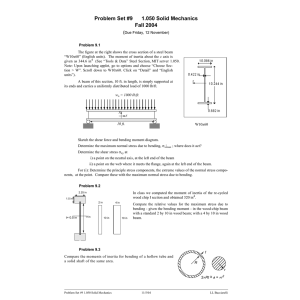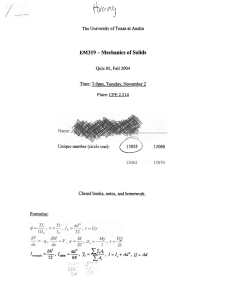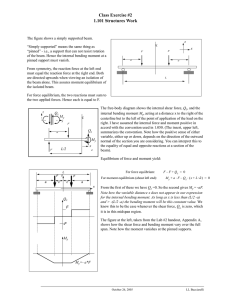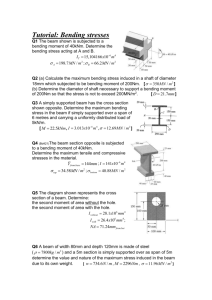The Cornu`s method for determining the elastic constants of a
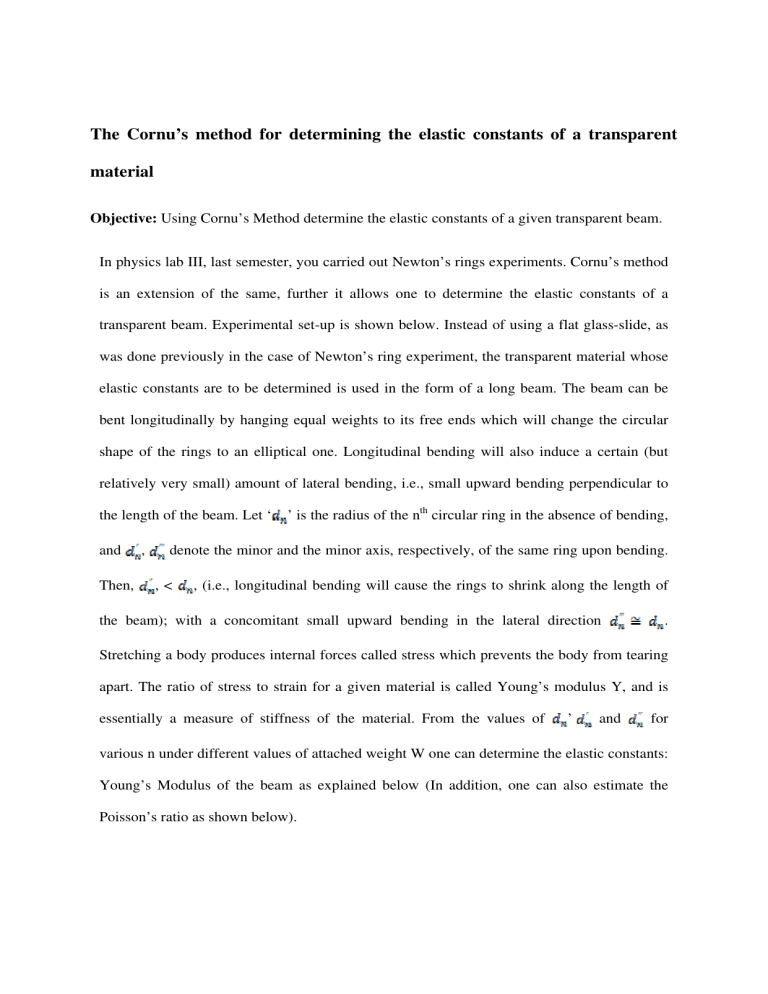
The Cornu’s method for determining the elastic constants of a transparent material
Objective: Using Cornu’s Method determine the elastic constants of a given transparent beam.
In physics lab III, last semester, you carried out Newton’s rings experiments. Cornu’s method is an extension of the same, further it allows one to determine the elastic constants of a transparent beam. Experimental set-up is shown below. Instead of using a flat glass-slide, as was done previously in the case of Newton’s ring experiment, the transparent material whose elastic constants are to be determined is used in the form of a long beam. The beam can be bent longitudinally by hanging equal weights to its free ends which will change the circular shape of the rings to an elliptical one. Longitudinal bending will also induce a certain (but relatively very small) amount of lateral bending, i.e., small upward bending perpendicular to the length of the beam. Let ‘ ’ is the radius of the n th
circular ring in the absence of bending, and , denote the minor and the minor axis, respectively, of the same ring upon bending.
Then, , < , (i.e., longitudinal bending will cause the rings to shrink along the length of the beam); with a concomitant small upward bending in the lateral direction .
Stretching a body produces internal forces called stress which prevents the body from tearing apart. The ratio of stress to strain for a given material is called Young’s modulus Y, and is essentially a measure of stiffness of the material. From the values of ’ and for various n under different values of attached weight W one can determine the elastic constants:
Young’s Modulus of the beam as explained below (In addition, one can also estimate the
Poisson’s ratio as shown below).
Figure 1: Experimental set-up for the Cornu’s method: (from left) Sodium lamp source for producing
Newton’s rings, side view of the apparatus, front view of the apparatus with weights. Thin air-film between a plano-convex lens and the Perspex beam produces circular rings due to interference. Upon attaching weights to the free ends of the beam and its consequent bending, the circular rings change their shape to an elliptical one.
Here is an outline of the analysis (workout the various expressions yourself):
Strain εεεε (z):
Elongation (contraction) of a plane a distance above “z” above (below) the neutral plane (see fig. 3) is given by:
ε (z) = z/R
1
(1)
Stress σ (z):
Young’s modulus (Y) = Stress/Strain = σ/ε i.e., σ (z) = Y.z/R
1
The bending moment is therefore given by:
(2)
(3)
(4)
Figure 4: Cross-section of a bent beam. Broken line indicates neutral plane. Please see also Figure 6.
Figure 2: Side view(s) of the beam whose elastic constants have to be determined in the unloaded condition
Under equilibrium, the internal bending moment (eq. 4) must be balanced by the moment due to weight m
1 g attached to its ends (eq. 5),
M r
= m
1 g.L
Combining (4) and (5) gives:
(5)
(6)
*Thus, if we can determine R1 from our experimental set-up, other quantities being known, the Young’s modulus of the beam can be calculated. But before that we should first calculate
R
0
(the radius of curvature of the plano-convex lens used).
Figure 3: Bending of a beam under a weight W = m
1 g each attached to its ends. M r
is the bending moment (= m
1 g.L). Lower panel shows an expanded view of the region over which the Newton rings form (region enclosed in a dotted circle in the upper panel). Due to bending, the upper half (i.e., half above the neutral plane) of the beam will undergo “expansion” while the lower half (below the neutral plane will undergo compression resulting in stress represented by arrows (section ab of the beam becomes a’b’ upon bending). The stress generated is indicated by arrows. A bent beam over a small region (region over which the Newton rings form) can be considered as an arc of a circle of radius R
1
.
I.
Determination of R
0
(radius of curvature of the plano-convex lens)
It is simple to Show that:
(7)
Where d n
is the diameter of the n th
dark ring.
Now, if you plot of “d n
2
“ as a function of “n”, as you did in the III rd
semester lab, it should be a straight line of slope λ .R
0
/4, which gives R
0
.
Figure5: Newton rings with and without bending shown, respectively, in the left and right panel. Note that bending is accompanied by change in shape of the rings from circular to elliptical. The diameter of the n th dark ring decreases greatly along the beam length and increases slightly perpendicular to the beam length in accordance with change in thickness of the air film sandwiched between the beam and the convex surface of the plano-convex lens (i.e., ).
II.
Determination of R
1
Using the same geometrical reasoning as is used in deriving eq. (7). It can be shown that R1 is given by:
(8)
By plotting (as done in part I) you can obtain R
1
from the slope of straight line, which leads to determination of Y.
So, far we did not consider the small but finite lateral bending. When a beam is made to bend along its length (longitudinal bending), it also undergoes a small lateral bending (see, figure 6), resulting in a lateral strain. That is the reason why in figure 5 major axis ( ) of ellipse is slightly greater than the radius of the corresponding circular ring.
The measure of this tendency is called Poisson’s ratio ( ζ ), given by:
ζ = lateral strain/longitudinal strain. With the help of eq. 1: ζ = R
1
/R2. Typically R
2
is much smaller than R
1
. (9)
III.
Determination of R
2
Show that:
(10)
By plotting (as done in part I and II) you can obtain R
2
from the slope of straight line, which leads to the experimental determination of Poisson’s ratio.
For comments and suggestions: please contact: surjeet.singh@iiserpune.ac.in
__________________________________________________________________________


